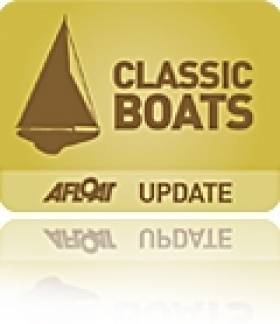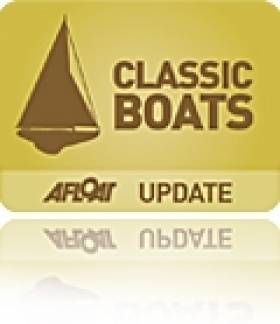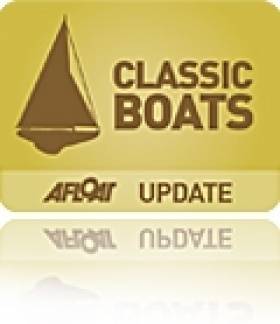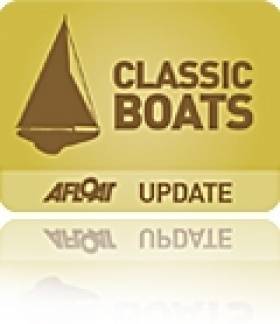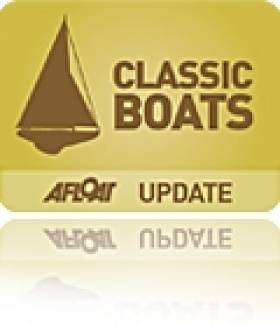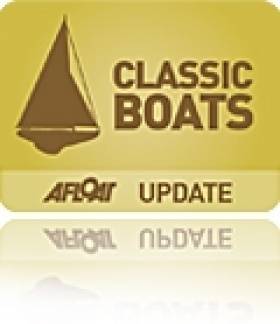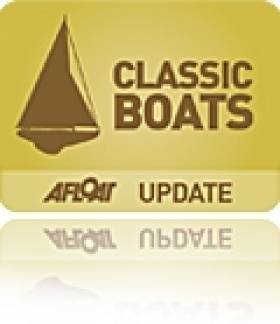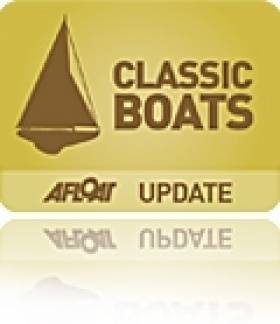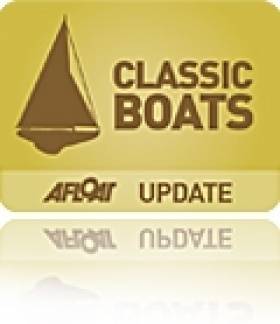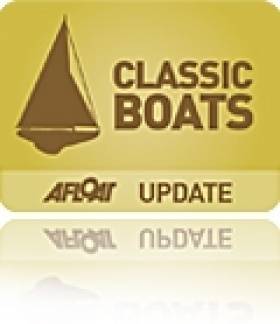Displaying items by tag: Classic boats
#ClassicBoats - An art conservationist is turning his hand to a restoration of a different kind - in the form of a vintage boat.
Simone Mancini, head of conservation at the National Gallery of Ireland, began work on restoring the hull of an old boat named Kara Third a couple of years ago.
And as the Dun Laoghaire Harbour Company website reports, he's now working on topsides for the hull that's now complete and looking as good as if not better than new.
"It has been a long enduring and rewarding process which required specific knowledge (here in big trouble) as much as passion (I was fine with it)," writes Mancini about his project.
"Talking to people who know a lot about this matter, necessarily becomes part of the process. Always told: it is a true labour of love, isn’t it?"
Though the Kara Third is a "work still in progress", it's remarkable to behold what an amateur in the boat restoration world has achieved thus far.
Royal Yacht Squadron to Hold Bicentenary Regatta in Cowes
#rys – The promise of a spectacle of timeless classic versus cutting edge modern is emerging early in the year as the entries for the Royal Yacht Squadron's Bicentenary start to lay down the gauntlet for the summer of sailing in England's Solent in the last week of July.
Three majestic J-Class Yachts, Velsheda, Ranger and Lionheart (pictured), will line up alongside other historic legends including the 48ft Tomahawk built in 1938 and 52ft Dorade, built in 1929. Both are Sparkman and Stephens designs. From the breathtaking schooner Eleonora at 160ft to the two 8 metre yachts Helen and Enchantement born 1936 and 1923 respectively, the event has been a magnet for the most immaculate and competitive classics in Europe and beyond. Several, including Dorade herself, are racing across the Atlantic from Newport, Rhode Island, to take part in this Royal Yacht Squadron's 200 years celebration.
Entries to date include the mighty 120ft–Briand designed sloop Bristolian, mini-maxi Jethou and many well known names in the performance IRC fleets including Ker 46 Tonnere of Breskens, Elan 40 Flair, TP 52 Gladiator, and Grand Soleil 43 Quokka.
The Swan class will be represented too - entries include Swan 57 Noonmark VI, which will also be taking part in the Transatlantic Race, and Swan 44 Rosy Pelican.
More from the Squadron here
New Lease Of Life For Record Breaking Offshore Yacht
#ClassicBoats - A Round the Island Race record holder left to rot at a Plymouth dock is set for a renewed lease of life on the open water, as the Plymouth Herald reports.
In her life as a racing yacht, the 72-foot Challenge Business 45 set a class record in the annual Isle of Man circumnavigation that still stands today, and was also victorious in the 2004/05 BT Global Challenge under the name BG Spirit.
But after sustaining damage to her mast and hull in a fall at a Plymouth boat yard three years ago, she was all but abandoned as repairs were thought to be too expensive.
That's where maritime businessman Brian Pogson comes into the picture, as he transported the yacht under her own steam to his Exeter boat yard for a survey - finding that the damage was localised to the impact zone and she was not beyond saving.
"I strongly felt that this stunning and well-built yacht was too good to scrap and that we could bring her back to life," said Pogson late last year.
The Plymouth Herald has more on the story HERE.
UK Based Tug Operator to Bring WWI Trawler ‘Viola’ Home from Remote South Atlantic Island
#BringViolaHome - SMS Towage Limited, the East Yorkshire based towage operator which entered the Belfast Harbour towage market last year, announced today that they are throwing their marine expertise behind an ambitious project.
For more than a decade Dr. Robb Robinson of Hull University has campaigned to bring the 'Viola' (launched 1906), a derelict and abandoned trawler from the remote South Georgia Island to its homeport of Hull, 100 years after she sailed to take up her part in World War I.
The former North Sea trawler, built in Beverley in 1906, was requisitioned in 1914 by the Admiralty and set sail on a mission to hunt U-boats and sweep for mines. Despite a successful campaign which saw her involved in the sinking of two U-boats she has yet to return to her home port of Hull.
"Some 3,000 fishing vessels were requisitioned and they fought that grim battle against U-boats and mines," said Dr Robinson.
"We hear very little about that, but had we lost that war then our ability to wage the whole First World War World have been compromised, because we would have been starved of supplies."
SMS Towage have put together a team of maritime engineers and salvage experts to travel to the remote British overseas territory to assess the vessels structural condition with a view to finally bringing her home.
The three-week project departed the UK on the 5th November making the 7,750 mile journey via the Ascension and Falkland Islands to her current resting place.
"It has been great to get involved with this special project," said Paul Escreet.
"I have been following Dr Robinson's efforts to bring Viola home for many years and am very proud to be able to contribute the time and expertise of SMS Towage to this cause. We can only hope that the conditions in South Georgia have aided in preserving the steelwork so that she can be lifted out of the water for the long journey home."
Further information on the history of Viola can be found by clicking PDF document HERE.
Progress Underway on Securing Naomh Eanna's Future
#NaomhEanna - Naomh Éanna a former CIE Aran Islands ferry due to be scrapped earlier this year as previously reported, has been acquired by the Irish Ship & Barge Fabrication Company, effectively securing the heritage vessel, writes Jehan Ashmore.
There are plans by IS&BF for a major refit of the veteran vessel that would see her become a tourist attraction back in her former homeport of Galway, as she would feature a boutique hostel, restaurant, cafe and museum in the harbour's single Dun Aengus Dock.
Naomh Eanna is a riveted hulled ship completed in 1958 at the Liffey Dockyard, she carried some 300 passengers and freight including livestock between Galway and the three Aran Islands. She has been lying derelict in Dublin Port for more than 25 years.
She is one of the last such ships built in Europe using rivetted construction technique. In addition she is one of the last ships to be built in the capital and is one of the oldest surviving Irish built ships remaining in our waters.
According to the Naomh Éanna Save Our Ship Campaign, there are negotiations with NAMA over a lease of the graving dock site in Dublin's Grand Canal Basin. This would allow surveyors to access the ship (currently in the graving dock) and determine her hull condition and machinery which is understood to be in working order.
Subject to the outcome of her survey, IS&BF intend to carry out the major refit of the 483 tonnes vessel with her new owners seeking investment from venture capitalists to invest in the project.
Since her shift of berth within Grand Canal Basin earlier this year, there has been an ongoing dispute by campaigners to save Naomh Eanna from scrapping by Waterways Ireland, the Department of Arts, Heritage and the Gaeltacht and NAMA.
Prior to Naomh Éanna's relocation earlier this year, she had been laid-up at her long-term berth alongside Charlotte Quay within the Grand Canal Dock since 1989.
The previous year she had been withdrawn from the west of Ireland service as she failed an inclination test and sailed to Dublin Port. She initially berthed in the capital close to the shipyard from where she was launched into Alexandra Basin.
#huffofarklow – The restoration of the classic yacht 'Huff of Arklow' is nearing completion in Cornwall and anticipating is building to see the 1951 John Tyrrell & Sons builkd back on the water in her original form next month.
The unique yacht designed by the famous Uffa Fox was built for Douglas Heard, a well-known Dublin yachtsman and the first president of the Irish Yachting Association, now Irish Sailing Association. Huff of Arklow was completely unique upon her construction and is believed to be the only example of a Flying Thirty left. She is an irreplaceable boat and has had a revolutionary effect on the history of yacht design. For these, as well as for many other reasons, she is worthy of preservation.
The objective of this restoration is to put Huff back into her original condition as far as possible. She has been underused in recent years causing a build up of moisture due to lack of airing and this encourages mould and corrosion. Her sailing performance has appeared to deteriorate over the last few seasons and perhaps we have never known her at her best simply because she is too heavy and too low in the water.
Huff is now owned by Eyemouth ISCA (International Sail Craft Association). Eyemouth ISCA is an educational charity and it has tied in the restoration project of Huff of Arklow to an NVQ2 apprenticeship in boat building. Two young men have passed a lengthy selection in order to achieve this placement based at Mashfords Boatyard, Cremyll, where Huff lays. The Falmouth Marine School provides the technical side of the course whilst the practical side will focus on the restoration of the Huff.
Huff of Arklow launch party will take place on 7th September!
A lively facebook page detials the restoration here
Special Radio Documentary: An Asgard
#Asgard – As the centenary anniversary of the Asgard's arrival at Howth Harbour approaches this weekend as previously reported on Afloat.ie, a special documentary is to be broadcast on RTE Raidió na Gaeltachta to mark the historic event.
The programme to be aired at 11am this Thursday, examines the historical impact of the yacht owned by Erkine Childers which landed a cargo of arms on 26 July 1914 for the Irish Volunteers that included rifles and ammunition.
A series of events marking the momentous event 100 years ago and that of the subsequent loss of life at Bachelors Walk will take place on Sunday 27 July.
Among the events taking place in Howth Harbour see the President Higgins will join Minister Humphreys to address and lead the official commemoration ceremony by the Defence Forces at the north Co. Dublin harbour's East Pier from 11.30am.
Following that, from 1pm the Asgard 100 Community Group will stage a re-enactment of the landing of arms, featuring a replica of the yacht Asgard and a flotilla of boats observed by President Higgins.
Local volunteers from the Howth GAA Club and marching volunteers from Dublin will unload and leave the pier with the consignment.
Historical context to the events of that day in late July 1914 will be provided by members of the Asgard 100 group throughout the proceedings.
For more details of all the events organised for the day, visit this link.
Historic Boats Shape Up for Solent's Classic Week
#classicboats – Cowes produced near perfect conditions for day three of Panerai British Classic boat Week where Squadron Racing Ltd ran two more excellent races in the Central Solent for the 52-strong fleet. With hot sun, a balmy sea breeze that built from sub 10 to almost 20 knots and more gleaming varnish and brass than you can shake a stick at, it was a spectacular day's sailing and great fun was had by all. With four of the seven race series now completed, the overall standings are shaping up and we can expect the next three days to be full of excitement.
In Class 3 Christine and Giovanni Belgrano's Whooper continues to dominate, winning both of today's races to make it four straight wins overall. Andy King's Gluckauf took second in both races and Rob Gray and Sam Laidlaw's Clarionet was third in both. In the overall standings Whooper unsurprisingly leads Class 3 with just four points. Although Gluckauf was the better performer today she is counting a Did Not Compete from yesterday's Around The Island Race and so Clarionet is lying in second overall on eleven points with Gluckauf two points behind them in third.
Mikado, owned by Michael Briggs, also claimed two first places today in Class 4 and so jumps into the lead overall with a seven point margin. After a lacklustre start to the regatta, Bob Gatehouse's Erida found her form this morning to finish second in race three, just ahead of David Foster and Ben Gillett's Leopard who also favoured this morning's lighter conditions. This afternoon Jonathan and Scilla Dyke's Cereste took second from David Messum's Nausicaa. In the overall standings Mikado is leading with seven points, Nausicaa is second on fourteen points and Cereste is third on twenty-two points.
Sean McMillan's Spirit 52 Flight of Ufford was once again the most consistent performer in Class 1, adding a first and second to their score card. Stephen O"Flaherty's Soufriere won race four and having claimed third in race three she now lies in second place overall, just three points behind Flight of Ufford. Michael Hough's Chloe had another good day with a second and third so lies just two points back in third overall.
In Class 2 race three proved to be somewhat controversial. There was a start line port starboard incident between David Murrin's Cetewayo and Ebsen Poulsson and Ed Dubois' Firebrand that later resulted in the Protest Committee awarding a 4% penalty against Firebrand. Then Cetewayo misjudged their approach to Gurnard Ledge and made contact with the buoy requiring them to take a 2% penalty. Jamie Matheson's Opposition was the clear winner of the race and after all the penalties were applied Firebrand was scored second and Cetewayo third. Race four was decided entirely on the water with victory going to Cetewayo with Opposition second and Firebrand third. In the overall standings Class 2 is now led by Firebrand on eight points, Cetewayo is second on nineteen points and Opposition is just one point further back in third.
In the 8 Metres the opening race of the day went to Christopher Courage's Helen who was also looking very good in race four until they became aware that the boat, which they only took possession of last week, was taking water fast. Unable to immediately trace the source of the water they pulled up on the final beat allowing their fellow competitors to sail on by. Back ashore they discovered the offending problem was a faulty bilge pump which was back filling. Christopher, who currently counts two wins and two retirements, joked that, "If we could just finish the races we'd be winning the regatta!" Whilst Helen had her dramas Murdoch McKillop's Saskia was proving to be the most consistent boat of the day with a pair of second places, while Athena finished third in race three and went on to win race four. In the overall standings Saskia now leads the 8 Metres by a single point from Athena with Helen two points behind in third.
This evening the participants are making the most of the wonderful weather with an Open Boats Dock Party sponsored by Classic Boat and Wight Vodka. This event is a perennial favourite as not only does it give you a chance to take a look at your competitors boats, but its also the perfect opportunity to compare battle stories and swop tips on the restoration and maintenance of these wonderful yachts.
Tomorrow will feature race five in the main points series followed by the Ladies Race, where the boats must helmed by lady. The first start will be at 10.00 from the Royal Yacht Squadron line with the second race following on. After sailing the Royal Corinthian Yacht Club will host the traditional crews party.
Racing continues until Friday 18 July and the event will conclude with a Parade of Sail past the Royal Yacht Squadron and Cowes Green at 11.00 on Saturday 19 July.
Classic Sailing Week Off to A Flying Start in Cowes
#classicboats – Panerai British Classic Week 2014 got off to a spectacular start off Cowes today with an opening race in dappled sunlight under scudding clouds and a variable west to northwesterly wind ranging from sub ten to almost twenty knots. For the fifty-one participating teams there was plenty of action as they enjoyed a round the cans romp that started and finished on the Royal Yacht Squadron line and took them down into the Western Solent. It was a challenging day for the navigators with an exceptionally strong ebb tide running making judging laylines extremely difficult.
First away from the line were the Modern Classics of Class 1, which includes the Spirit class yachts and yachts that the Committee of the British Classic Yacht Club consider to be built with the appearance of "a classic". From the off it was a three way battle between the Spirit 52s Flight of Ufford, owned by Sean McMillan, and Chloe, owned by Michael Hough, and Spirit 54 Soufriere, which is owned by Ireland's Stephen O'Flaherty, but is perhaps better known to the general public as the yacht James Bond sailed up Venice's Grand Canal in Casino Royale. Having traded tacks and gybes all the way round the course it was Soufriere who claimed first blood, beating Flight of Ufford by 12 seconds with Chloe only half a minute behind in third.
In Class 2 David Murrin's 1955 Laurent Giles designed Cetewayo got the upper hand early on and extended her lead on each leg to win the race by over eight minutes on corrected time. Behind her there was a splendid battle for second between Jamie Mattheson's Opposition, the former Morning Cloud II, and Ebsen Poulsson and Ed Dubois' Firebrand, a 1953 Sparkman and Stephens design. Firebrand finished well ahead on the water but her crew had an anxious wait for the lower rated Opposition to come in. Quick action with the calculator confirmed that Firebrand had taken second place by eight seconds with Opposition third.
"A fabulous day's sailing. Just perfect." enthused David Orton of St David's Light, the 40' Illingworth and Primrose designed one off masthead sloop built in 1963 by Souters of Cowes who finished fourth in Class 3. First place in Class 3 went to Christine & Giovanni Belgrano's 1939 one off sloop Whooper, with Andy King's 1929 International 30 Square Metre Gluckauf, fondly known in the fleet as the flying toothpick thanks to her exceptionally long and low profile, second and Rob Gray's Clarionet, the legendary Lallows' built, Sparkman and Stephen's designed 1966 fin and skeg One Tonner, third.
In Class 4, just 30 seconds separated first placed Cereste, a 1938 Shoreham Ten Tonner designed by Robert Clark and owned by Jonathan and Scilla Dyke, and second placed Mikado, Sir Michael Briggs' 1904 Fife designed 30 Rater, one of the oldest boats in the regatta. The sloop Danegeld, owned by Robert Veale, designed by David Cheverton in 1958 took third place. One owner very happy with his boat's performance today was Jason Fry of the 1946 Philip Rhodes designed sloop Shantih. Jason only took ownership of the boat last week and has been rushing around desperately to get ready for the regatta. He wasn't able to get a spinnaker sorted in time for the week, but despite this they finished a very creditable fifth in Class 4 today.
In the 8 Metres Christopher Courage's 1936 built Helen was the victor from the 1949 Erica, owned by David Myatt, with Murdoch McKillop's 1931 Fife Saskia third. After racing David Myatt confirmed they had enjoyed their day, but were mildly frustrated having misjudged their final mark rounding in the strong tide and allowed Helen to slip through and get away from them.
Tomorrow the boats will be taking part in the Around The Island Race sponsored by EFG International, which starts to the East from the Royal Yacht Squadron line at 08.00. The 8 Metres will not race around the Island, but instead will have a Solent race starting from the Royal Yacht Squadron at 10.00. The forecast is for lots of sunshine and a north northwesterly wind of circa 10 knots in the morning, backing southwesterly and increasing into the high teens through the day.
This evening the competitors will enjoy a Welcome Reception at the Royal Yacht Squadron and tomorrow morning the Panerai Lounge will open from 06.30 to serve coffee and croissant to the competitors before they leave the dock.
Racing continues until Friday 18 July and the event will conclude with a Parade of Sail past the Royal Yacht Squadron and Cowes Green at 11.00 on Saturday 19 July.
Full results and further information about Panerai British Classic Week can be found at the regatta website www.britishclassicyachtclub.org/regatta. Those wishing to receive further information about the regatta should contact Mary Scott-Jackson on [email protected].
#STBFestival. – Weigh your anchor, fill your sails and get ready for the 2014 Aberdeen Asset Management Scottish Traditional Boat Festival. Thousands of visitors are expected to attend the 21st annual festival which will be taking place in Portsoy, Aberdeenshire from June 27-29th 2014.
Scotland's leading celebration of maritime and cultural heritage is one of the key events in The Year of Homecoming, with the theme reflected throughout the festival programme. The event will showcase the best in Scotland's maritime, crafts, food, drink, music and dance, with a special emphasis on boat building, restoration and sailing.
Traditional wooden boats from all over the UK and beyond will congregate in the historic 17th century Portsoy harbour. Visitors will be able to learn how to sail a coracle, climb aboard restored fishing vessels, and see the crews of the St Ayles Skiffs battle it out on the open seas in the annual regatta. This year will also see the official opening of the PORT Boatshed, a community boat building workshop which allows training and restoration to be undertaken.
Aberdeen Asset Management Scottish Traditional Boat Festival Chair, Roger Goodyear, says, "The Festival has a great programme that offers a fantastic traditional maritime experience. Each year our Festival continues to grow stronger and draw in huge crowds- the small town usually only has a population of 2000 people, and this rises to an incredible 16,000 people over the weekend of the Festival.
"Now in its 21st year, we hope to continue to build on its enviable reputation for showcasing the very best in traditional maritime festivities with a range of craft, food, drink, music and dance events. What started as a small community celebration to mark the 300th anniversary of Portsoy harbour has grown to become recognised by VisitScotland as one of the region's flagship tourism events, which is a fantastic boost."
The music programme will feature the very best of traditional music including popular Scottish folk singers and local favourites. The music line up this year reflects the Year of Homecoming by bringing together local musicians and performers from around the world including headliners RURA, festival favourites De Kinkels from the Netherlands and Slogmaakane, fabulous shanty singers from Norway.
The festival craft marquee is set to attract artists and craft workers from across Scotland, while food and drink from the North-east's larder will on show at the Wally Green Food Fayre.
Caroline Packman, Homecoming Scotland Director, says, "Homecoming places the spotlight on our greatest assets and celebrates all that's great about our country, so it's only fitting the Scottish Traditional Boat Festival is part of the packed Homecoming programme of events. Scotland is the perfect stage for major cultural events and the Boat Festival provides a truly enchanting example of the regions rich heritage and culture. Whether you are interested in crafts, historic vessels, boat races or it's simply a day out with the family - there's truly something for everyone at Portsoy."
For more information about the Festival and to buy tickets visit www.stbfportsoy.com.
An adult day ticket to the festival costs £8, children aged five to 18 and concessions are £5. Adult weekend tickets are priced at £12 and children and concessions at £8. There are also family tickets available which allow entry for two adults and three children for £25 for a day ticket and £35 for a weekend. Children under five go free. Car parking is available and costs £2, with the price including a brochure.


























